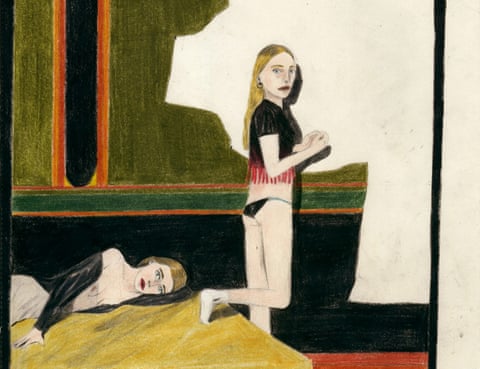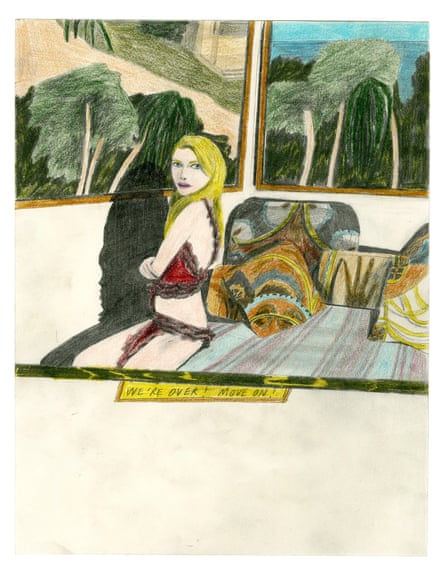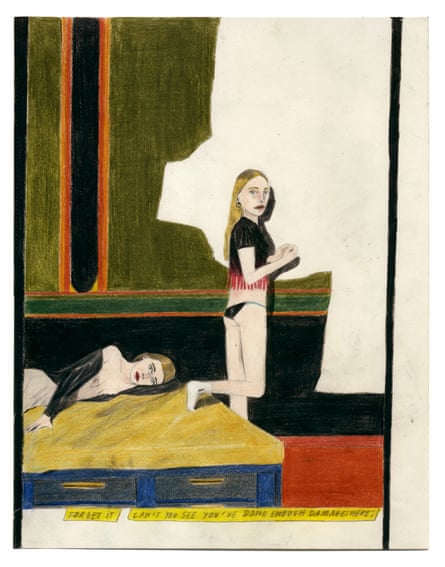
‘Everything is hairless’: what 100 women taught me about porn and body confidence
How is pornography changing women’s perception of what is normal, acceptable and beautiful? I interviewed them to find out

‘No one clarifies what your body is supposed to look like, or what it does, or what sex is.’ Illustration: MARIE JACOTEY/The Guardian
‘Everything is hairless’: what 100 women taught me about porn and body confidence
How is pornography changing women’s perception of what is normal, acceptable and beautiful? I interviewed them to find out
by Fiona Vera-Gray
Tue 20 Feb 2024 00.00 EST
Sorrel grew up during the 1970s, in a big Caribbean household in the north of England. One of two girls in a family with four boys, she learned early that not only was her vulva not to be looked at – it wasn’t even something she could name. “It was called a ‘munchie’,” she says. “We weren’t allowed to touch the munchie, we weren’t allowed to see the munchie, and we definitely weren’t allowed to speak about the munchie.”
In this, Sorrel and her munchie still aren’t alone. No matter what we call it, many women grow up with the sense that there’s something unspeakable “down there” – and it shows. A 2019 poll of the British public found that 45% of women couldn’t label the vagina. Another, in 2021, found that, regardless of sex, more than a third of the people surveyed couldn’t locate the clitoris. It’s not something exclusively British, either; in 2010, an advert by the tampon company Kotex was banned by three US television networks just for saying the word “vagina”, and a 2020 poll found that roughly half of US women couldn’t identify the cervix or the uterus.
Part of the reason for this confusion could simply be biology: the very nature of the female body means it requires effort to look at in detail. We need mirrors, torches, particular positions. It’s purposeful; you need intention. But the ready availability of all kinds of pornography has given more access to female bodies than ever before. What does that mean for how we feel about our own?
Almina told me that most of her friends had seen pornography by the age of 15 and, usually, it wasn’t by choice. She was 18 when we spoke, and still remembered being 12 and having boys message her pictures and videos from adult sites, telling her she should go on them. She was intrigued. “Everyone is saying: ‘Don’t go near it.’ I was just interested in what was going on – what sex looked like, what their bodies looked like and what they were doing.”
This desire to use porn to understand not just sex but bodies created a real problem for Almina. And it wasn’t just because of the controversial ways in which porn depicts women: Almina is black, and all the bodies she saw were white, which left her feeling as though her body was wrong. “Most porn shows white women. I wasn’t watching porn with black women in it when I was growing up and developing,” she said. “I have stretch marks and strawberry legs [follicles or blocked pores that appear as black dots]; discoloration all over my body. Even my vulva area is darker than the rest of my body. When you watch porn, their entire body is one colour and looks perfect. I thought there was something wrong with me.”
Almina grew up in the age of the internet and the infinite supermarket of pornography it provides. The sheer volume of pornography made her feel even more like the odd one out. “No one clarifies what your body is supposed to look like, or what it does, or what sex is,” she told me. “And then you see that a video has 10m views and you think that if it has that many, that body must be desirable and that must be what sex should look like. Everyone says it’s not reality, but that doesn’t sink in because there’s nothing else to compare it to.”
Pornography hasn’t only had this impact on younger women. Luce is almost 30, and has been using pornography for years. She believes it has helped her explore her sexual desire, given her permission to experiment, to figure out more about her sexuality. But some of its impact on her body image remains. “The women that I see in pornography have a very specific look; they have these very fit bodies and these perfectly waxed vulvas. Everything is hairless,” she says. “The worst thing for me is the inevitable comparison that I sometimes give myself. It doesn’t happen very often, but when it does it’s another reminder of how not perfect I am.”

View image in fullscreen
Illustration: Marie Jacotey/The Guardian
The widespread impact of pornography on body confidence – for men and women – is beginning to show. In 2022, health researchers in Spain conducted a review of existing findings on pornography’s relationship to body dissatisfaction and found compelling evidence that the more pornography you see, the worse your personal body image becomes. Across 26 studies, only three found no association between pornography exposure and negative body image and – despite the fact that men who watch pornography are regularly confronted with penises that are bigger, thicker and harder than theirs – the impact on physical self-esteem was most pronounced for heterosexual women. And especially about one particular part of the anatomy: the vulva.
This matters perhaps more now than ever, given that pornography use in young women is increasing. Last year, the Children’s Commissioner found that 42% of girls had sought out pornography, compared with 58% of boys – not a glaring difference. And while much of the policy focus and public debate has been about how pornography affects the sexual attitudes of boys and men to the negative, there’s been less attention paid to its impact on girls and women. But that is having real life consequences too.
Isobel, a GP, had started to notice a pattern in the younger women who came in. She was close to 40 and, though she had started watching pornography herself in recent years, she felt fairly ambivalent about it. She was more concerned about the impact it had on other people.
“I have a lot of reservations generally about the pornography industry; about people being exploited, people’s health and safety,” she says. “I also have some concerns about whether mainstream porn gives people an idea of sex as something that men do to women. And then there’s the impact it’s having on bodies and what people expect to be normal and achievable. I don’t want to be judging people who have had cosmetic surgery, but most people’s bodies don’t look like they do in porn.”
Isobel had been worried about the number of women coming into her practice thinking there was something wrong with their vulvas. But it wasn’t only because they had seen other vulvas in pornography; it was more about what porn had meant for them seeing their own. “Nobody has any pubic hair any more,” she says. “Pretty much everybody under 40 is waxed completely. I think porn starts to impact on people even if they [don’t] use it. If there is a general awareness of what images are out there and what other people’s expectations are, it spreads.”
Isobel didn’t care about the hair itself. But it was affecting what patients presented with, because it often revealed their vulvas for the first time. It took a lot of them aback. “‘My labia are too big.’ We hear that now fairly often. I say: ‘Yes. That’s because when you had a load of pubic hair you couldn’t really see them. Of course they look more prominent.’”
It’s not surprising that pornography can have this impact, given how much women are taught to judge themselves and each other, and there aren’t codes or standards in the way there are for advertising or broadcasting. Despite this, the impact isn’t always negative. For Hester, it’s been quite the opposite.

View image in fullscreen
Illustration: Marie Jacotey/The Guardian
Hester is a 36-year-old white woman who had two kids in her mid-20s. She was also bisexual and married to a straight man, which gave pornography a particular purpose. “For me, porn is about meeting the needs or interests that aren’t met in my actual relationship,” she says. “Not filling a gap exactly – but it’s the bits of me I don’t get to express day-to-day. I am much more interested in queer porn, not in watching straight people have sex. I find the mainstream stuff quite violent, gross and exploitative-looking. I can’t speak for all women but I don’t want to see some girl with guys coming all over her face.”
That meant that Hester was active in seeking out pornography that interested her – not just what was available on the big, popular sites. It also meant she was critical of the pornography debate more broadly, and what it means for how we think about women and their relationships with sex.
“The way most of the mainstream policy debate around porn is framed gives women no agency. We’re just passive victims,” she says. “Whether that is people producing porn or people as consumers, there seems to be no acknowledgment of women as sexual beings – rather than people that bad things happen to, done by bad men. If you say, ‘Porn is just terrible. It’s disastrous and ruining our youth,’ then that takes away our ability to talk about it. The reality is that loads of people, I would guess the majority, have some experience with porn. But if the debate is framed as ‘only deviant people do this’, then it stops you having a sensible conversation with young people.”
Partly as she was looking for pornography that she found less exploitative and more empowering, Hester also had a different experience with the impact it had on her body image. She said she had found it positive to see bodies that looked like hers; that aren’t perfect and don’t conform to an internalised ideal. And she also thought that this was missing from the public conversation: the possibility that porn could play a part in helping women understand that actually there’s no such thing as normal.
“One of the things that really bugs me,” she says, “is all the hand-wringing about people getting unrealistic expectations from porn about what genitalia should look like – about body hair, the idea of perfect vaginas and the pressure that puts young girls under. That might be true to an extent, but the fact is that most girls have not seen anyone else’s vagina. So, seeing some on the internet is more useful than not seeing any. It helps normalise human bodies.”
She still thinks it could be better. “I don’t want to see loads of fake t*ts,” she says. “But it’s better than not seeing any and thinking you’re the only person who looks like you do. It might be flawed but at least it’s something.”
On the one hand, pornography can help women learn about themselves; embracing the range of bodies as a means of making sense of, and accepting, our own. On the other, we’re in a world that judges bodies based on gender, sex and race. Pornography isn’t just produced and used in that context – it plays a fundamental role in creating it. What we need more than anything is to open up the conversation. To move beyond polarised positions, stigma and stereotypes, and begin to talk about what we do with porn. And in turn what it might be doing to us.
Women on Porn: One Hundred Stories. One Vital Conversation by Fiona Vera-Gray is out now published by Torva